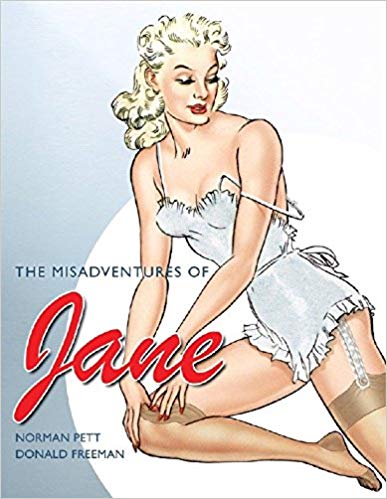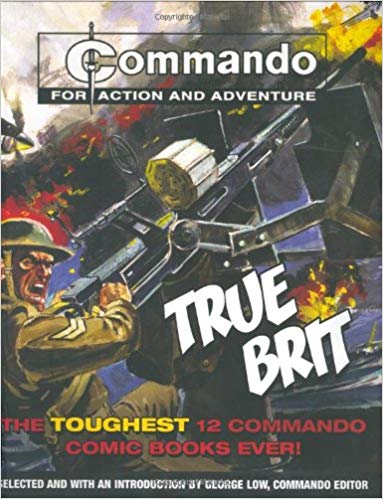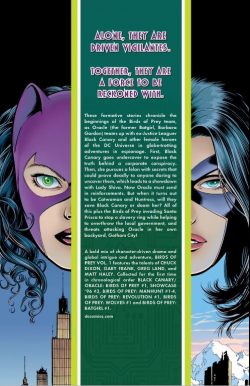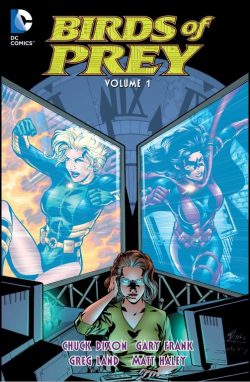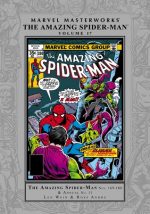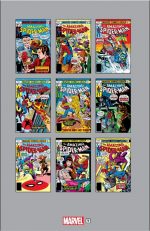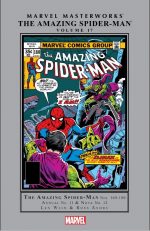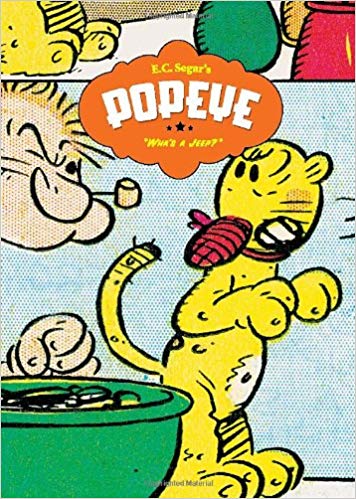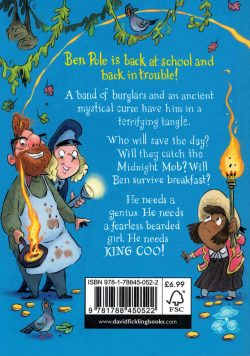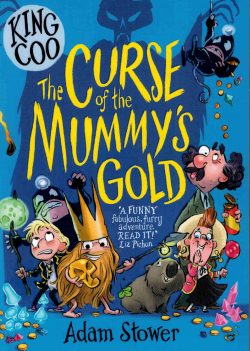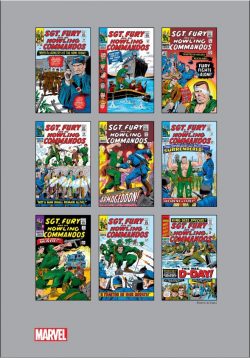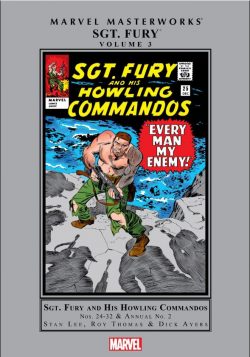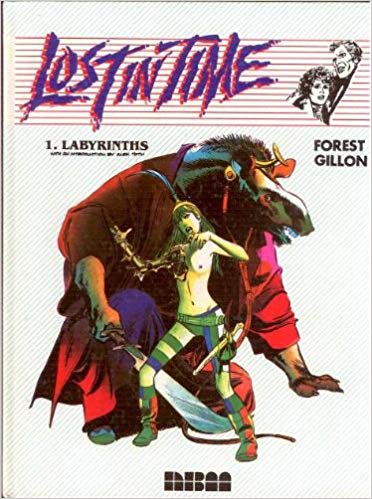
By Jean-Claude Forest & Paul Gillon, with an introduction by Alex Toth (NBM)
ISBN: 978-0-91834-818-0 (HB)
France has had an ongoing love affair with science fiction that goes back at least to the works of Jules Verne and – depending upon your viewpoint – arguably even as far back as Cyrano de Bergerac’s posthumously published fantasy stories L’Autre Monde: ou les États et Empires de la Lune (The Other World: or the States and Empires of the Moon) and Les États et Empires du Soleil (The States and Empires of the Sun) published in 1657 and 1662. Moreover, their comic iterations have always been groundbreaking, superbly realised and deeply enjoyable.
A perfect case in point is Les Naufragés du Temps (alternately translated as either Castaways in Time or, as here, Lost in Time) created in 1964 by Jean-Claude Forest and classical master-draughtsman Paul Gillon.
Forest (1930-1998) was a Parisian and graduate of the Paris School of Design who began selling strips while still a student. His Flèche Noire (Black Arrow) led to a career illustrating for newspapers and magazines such as France-Soir, Les Nouvelles Littéraires and Fiction in the 1950s, all whilst producing the Charlie Chaplin-inspired comic series Charlot and acting as chief artist for publisher Hachette’s science fiction imprint Le Rayon Fantastique. For this last client he produced illustrations and covers on translations of imported authors A. E. Van Vogt, Jack Williamson, and others.
In 1962, Forrest created Barbarella for V-Magazine and his sexy-charged icon quickly took the country and world by storm, consequently generating an explosion of like-minded SF Bandes Dessinées features. Forest never looked back, subsequently creating Baby Cyanide and more serious tales like Hypocrite; the Verne-inspired Mysterious Planet; La Jonque Fantôme Vue de l’Orchestre and Enfants, c’est l’Hydragon qui Passe.
He also found time to script for other artists: Ici Même for Jacques Tardi, occult detective series Leonid Beaudragon for Didier Savard and, with Gillon, the subject of today’s review – a classic of both comics and science fiction inexplicably all-but-ignored by English language publishers since the 1980s. If you read French, however, all volumes are still available in print and digitally…
Paul Gillon (1926-2011) was also born in Paris but suffered from debilitating tuberculosis in early life. After his full recovery, the isolated shut-in became something of a brilliant wild child, expelled from many schools – including the prestigious Ecole des Arts Graphiques.
As a teenager he considered a career in film, theatre or fashion, but slipped almost accidentally into the world of cartooning and caricature, working freelance for such arts magazines as Samedi-Soir, France Dimanche and Gavroche.
The end of WWII created chaotic circumstances in France, subsequently spawning a whole new comics industry, and in 1947 Gillon began illustrating for the popular weekly Vaillant, both on existing adventures strips such as Wango and Lynx Blanc (both written by Roger Lécureux) and Jean Ollivier’s Le Cormoran, as well as the later spin-off Jérémie which Gillon also scripted. In 1950, he created Fils de Chine (Sons of China) with Lécureux which ran for three years.
Working in a refined and highly classicist style epitomised by the likes of global industry giants Alex Raymond, Milton Caniff and Hal Foster, Gillon also wrote and drew shorter complete pieces for titles such as 34 Camera, Femmes D’Aujourd’hui, Reves and Radar, but his big break came in September 1959 when he began illustrating a daily soap-opera strip for national newspaper France Soir.
He would render the stunningly beautiful human heartbreaks of 13, rue de l’Espoir until the end of 1972, becoming a household name in the process…
Based on the American serial The Heart of Juliet Jones and scripted by Jacques and François Gall, the feature followed the fortunes of vivacious Parisienne Françoise Morel, and unfolding daily took the heroine and the Family Morel through some of the most tumultuous years of modern European social change, in nearly 4200 strips which were naturally compiled into two collected Albums – something else which should be translated into English but probably won’t be…
Throughout that period Gillon continued in comics, producing Jérémie, working for the Disney comic Le Journal de Mickey and other magazines while trying out new venues and genres.
Les Naufrages du Temps first appeared in 1964, part of the line-up in short-lived French comic Chouchou. A decade after the periodical closed, the strip was reprinted and saga completed in France-Soir before being released as 2 bichromic (a two-coloured palette) albums from major publisher Hachette in 1974 and 1975. Two further full-colour book volumes followed in 1976.
In 1977 the saga was serialized in groundbreaking Sci-fi magazine Metal Hurlant, prompting publisher Les Humanoides Associes to re-release the four albums (L’Etoile Endormie/The Sleeping Star; La Mort Sinueuse/The Creeping Death; Labyrinthes/Labyrinths and L’Univers Cannibale/The Cannibal Universe) in colour, before continuing the series with Gillon scripting as well as illustrating until its end in 1989: a total of six further volumes.
Never idle, Gillon then created spy-thriller Les Leviathans (The Leviathans) for Les Humanoides and adult science fiction epic La Survivante (The Survivor) for L’Echo des Savanes. He also adapted literary classics such as Victor Hugo’s Notre Dame de Paris and Herman Melville’s Moby Dick and re-imagined the legend of Joan of Arc as the erotic epic Jehanne.
His later efforts included Processus de Survie (Survival Process) in 1984 and La Derniere des Salles Obscures (The Last of the Dark Rooms) in 1998. He was still creating comics well into the 21st century and remains one of France’s most honoured, celebrated and revered comics creators, so just why so few of his incredibly illustrated tales have been translated is an utter mystery to me.
One that did make the jump was Lost in Time: Labyrinths, released as a spectacular hardback by NBM in 1987 and one of the few European imports to be seen “cold†in the USA (i.e. without first running as a serial in Heavy Metal magazine). As cited above it was the third album of the French series and opened with a much-needed preamble…
So just to recap something we hadn’t actually seen: at the end of the 20th century, humanity was imperilled by “the Scourgeâ€: a plague of extraterrestrial spores and/or a global sickness of its own negligent making.
Chris Cavallieri and Valerie Haurele were selected for a shot at survival and placed in suspended animation in individual space-capsules to preserve the best of our race and possibly reconstruct our lost glories in a newer age…
A thousand years later Chris was awakened into a bewildering but thriving multi-species civilisation in deadly danger. Earth was a derelict, plague world inhabited by mutant monsters whilst society abandoned it and grew to inhabit a hugely re-configured Solar system.
Helping the inhabitants of the patchwork “System†– ex-pat human, alien and genetically altered/hybridised animal-beings – to defeat an invasion by alien winged rats dubbed the Thrass, Chris fortuitously found Valerie’s lost capsule and revived her – but the longed-for happy reunion led to utter disaster.
Throughout their millennial slumber both ancient human lovers had dreamt of each other and a perfect meeting, but once they were together again in a furious new future, they discovered that they could not stand each other…
This tale begins after the defeated Thrass have fled the System and Valerie, rejected by Chris, has disappeared. The resurrected Ancient and his new-found true love Mara (one of the scientists who first recovered and rehabilitated Christopher) are the topic of much discussion amongst his new friends Dr. Otomoro and military cyborg Major Lisdal. Chris haunts morgues and seedy dives of the pan-cosmopolitan city of Roobo-ein-Sarra on System capital Limovan, unable to shake his destructive, obsessive fear for the fate of his millennial ex-lover…
Depressed, despondent and bitterly confused, Chris roams the exotic streets and bazaars where hordes of newly-liberated beings manically celebrate their hard-won freedom and security, unaware that he has been targeted by sinister plotters. An old “frenemyâ€, Morfina, accosts him and, past injuries and seductions forgotten, lures the old Earthman to the Mood Market, a vast, baroque area of bordellos run by a legendary criminal overlord. The Boar is a burly, erudite and unctuous humanoid with a Tapir’s head and plenty to hide…
(In the original this major series villain is in fact the Tapir – I’ve no idea why he was so erroneously renamed but have a sneaking suspicion that it involves European prejudices about English and American educational attainment…)
Completely off-guard, Chris succumbs to sybaritic release and is framed for the murder of a diplomat and his companion whilst out of his head. Once awake and panicked by the corpses around him, the Last Earthman accepts the extremely costly aid of the Boar to escape…
Even Christopher believes himself guilty until he discusses the affair with Mara, Lisdal and Otomoro in the cold light of day. However, even as the wool is pulled from his eyes and he realises his precarious predicament, the bamboozled human is utterly unaware that The Boar is working with compliant, vindictive Valerie, who is briefing the crime-lord on all Chris’s secrets…
When Lisdal suggests seeking help from brilliant scientific maverick Saravon Leobart, the friends are welcomed by the aged sage, but the Boar moves quickly, sending his gamin cyber-assassin Baby to quickly whisk Chris and Mara away under the pretext that the police have arrested Lisdal and Otomoro…
It’s all a colossal bluff: The Boar needs Chris to recover a deadly pre-Scourge secret weapon cached away at the time of humanity’s fall, and all the data needed to find and operate it lies buried in his Ancient subconscious. Chris is completely unaware that the thing even exists: his mind was re-programmed before his hibernation and only vengeful Valerie holds the secret of retrieving it…
Soon the Boar and his “guests†are hurtling deep into the outer system with Leobart, Morfina and Chris’ chums in hot pursuit. After a brutal clash in space, Chris and Mara are rescued but the Boar is ready and willing to retaliate. Moreover, benevolent Leobart is not all he seems…
To Be Continued…
This is a beautiful, stately and supremely authoritative adult fantasy thriller, tantalisingly teasing the reader with the promise of so much more. The second part was released in English as Lost in Time: Cannibal World in 1987, but even that only moved the saga forward without comfortably ending things. As far as I know, the only other Gillon works to make it into English are the first two volumes of The Survivor…
Mature, solid science fiction with thoroughly believable and pettily human characters confronted with fantastic situations, lots of action and loads of gratuitous nudity: how on Earth has this sublime series remained a secret French Possession for so very long? And can we please end that particular embargo soon?
© Les Humanoides Associes. © NBM 1986 for the English edition.
